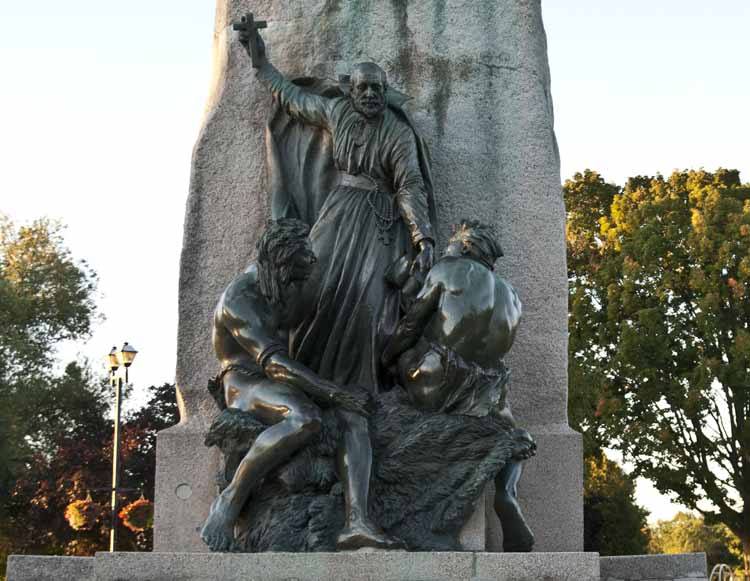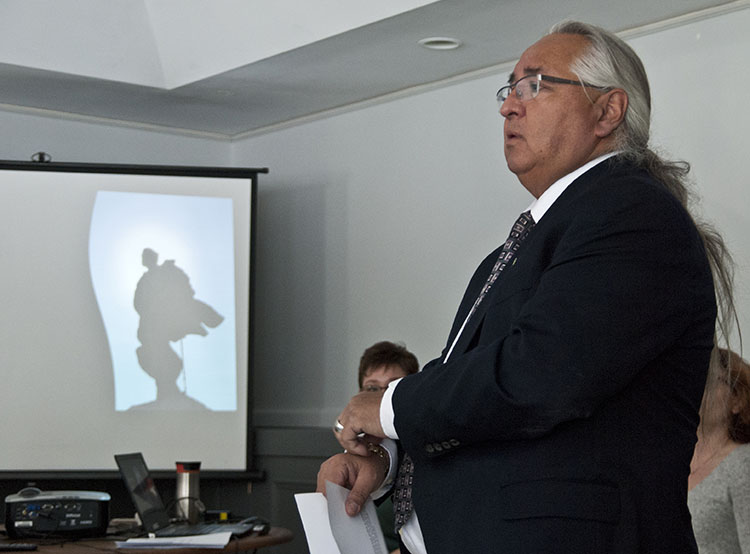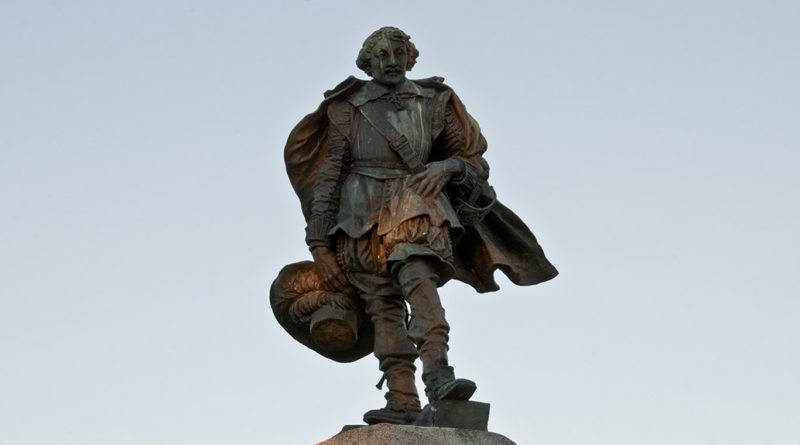Champlain Monument Workshops This Week
By John Swartz
Lots of people have an opinion on the Champlain Monument. Lots of people don’t know what they are talking about.
It doesn’t matter whether you want it back just as it was, though cleaned up, whether you want it back as long as there is something else to explain the other side (First Nations) of the story, or whether you never want to see it again you may have all the wrong reasons for your opinion.
How does one know? If you attend one the City of Orillia’s workshops later this week about the monument, you’ll quickly find out, even if you think you know a lot about the monument, there so much to learn. And you should learn more if you intend to fill out the survey/questionnaire because informed opinion will help the folks at Parks Canada make the decision on its return.
What follows is an account and interpretation of things learned at the March workshop which should be basic knowledge, but unfortunately is not for many.

For instance, did you know the priest and the trader are real people being depicted? The priest is Friar Le Caron according to Bruce McRea. McRae is one of the people here in Orillia that makes it his business to search out history’s stories. It turns out Le Caron was the first person to translate several First Nations languages into French and compile them into a dictionary. To do that he had to live among the various tribes, which he did for most of his life.
On the other side, we have Étienne Brûlé according to McRae. Brûlé represents the commerce side, fur trading, of the monument. If there is misrepresentation this is it. Brûlé, while probably having to trade to make his way through Ontario, New York and Pennsylvania, was an explorer. He was Champlain’s scout, which means it was Brûlé who was the first European to set eyes on the new land. He never returned to France and lived his life among Indians as a choice, that’s how acclimatized he became to living among the Algonquin, Huron, Iroquois and Obijway.

Those descriptions of Le Caron and Brule don’t sound like they were the type of subjugators many people have made the brass figures out to be, does it? Indeed, it doesn’t to many. The problem some people have with the monument rests on the positions and perceived expressions of the Indians making up the two side sculptures. That opinion they are cowering, afraid, or what have you is not held by all.
This writer sat with a group made up of McRea, Marcel Rousseau, Ted Duncan and Dan Shilling, four of the most knowledgeable people about our local history. None of us at the table view the Indian figures as lesser people. It’s been observed the opinion of our friends from Rama is not universally against the return of the monument as some other media portray First Nations people believe. It’s interesting to note, Shilling holds the opinion the statue is a work of art and should be returned (with a caveat).

“I have to be very careful, I’m not a politician and I don’t want to be perceived as speaking for my community, but as somebody who has a love and appreciation for art, changing one’s integrity of an artist’s perspective is important. It is a reflection of what happened in 1918, not today. I clearly believe another story needs to be told, a story that will compliment the monument,” Shilling said.
The workshop imparts information about the statue while attempting to get opinion on what to do about it. The information comes from Jacqueline Soczka, Orillia’s manager of culture, and Karen Feeley, Parks Canada’s public relations person.
The monument was the brainchild of Charles H. Hale. His vision was it be a token of friendship and cooperation between English and French Canada. The evidence of historical record does not indicate First Nations relations entered his mind, though it appears the notion of depicting Champlain and the other Frenchmen and the whole conquest of Canada as the natural flow of things from a superior culture over a savage culture was certainly the view of several others who joined the effort to create and place the monument.
The sentiment of the majority of those involved and of the general populace’s understanding of relations with First Nations at the time is represented in the unveiling speech given by Rodolphe Lemieux, the Speaker of the House of Commons, who said:
”They planted here a new society in the principles of the purest religion; they subdued the wilderness before them; they built temples to the true God where formerly had ascended the smoke of idolatrous sacrifices; they broke the first sod where now extend fields and gardens, and stretching over the hills and valleys which had never until then been reclaimed, can now be seen in the autumn, the waving of golden harvests. From the farms, the factories, the villages, the cities, the firesides scattered in Ontario and Quebec is raised the joyous murmur of wealth, agricultural, industrial, and commercial.”
Fact is, the Huron were farmers they had their version of a city at Cahiagué, present day Warminster. It was war with the Iroquois and disease brought by the French that forced them to move away. Lemieux’s description is rubbish. The Chippewa were nomadic hunters and fishers who certainly came here for those purposes, but didn’t settle here until about 100 years after the Huron left.
The plaque affixed to the monument is also contentious. The term, ‘white race’ is in the first sentence. We know what that means today, but as McRea points out it meant something different in 1925, the year the monument was erected. Back then, the term was used to describe ‘kinship’ as McRae called it. Yes it does describe colour, but it’s believed it meant a categorization rather than an ordinal characteristic because to the English, the Scots, Irish, French, etc. were different races too (and vice versa). The plaque wording, “A symbol of good will between the French and the English speaking people of Canada,” without mention of those who were here first should be the highest order of discontent. It’s a safe bet the plaque, as is, will never be reinstalled.
Another tidbit of info, the monument and the land it sits on was transferred to the department of Northern Affairs and Natural Resources in 1955, the feds own it (which may come in handy to know in light of the City’s new smoking ban).

Getting feedback is Michael Jones’s and Erin Dixon’s job. They facilitate the group sessions and set the stage for discussion around three areas: What does the monument mean? What do you think it should mean? and, How would you tell that story?
The more you know shapes how you respond to each question, and there is one piece of information revealed which is enlightening and consequently shaped opinion for many of the workshop attendees regarding the possible answers to the third question. It won’t be revealed here so attendees of the next two workshops get the same sense of surprise we all did at the first workshop. In a forthcoming piece to be published after the workshops, that information will be stated here in SUNonline/Orillia.
Feeley, answering a question, said the decision on the monument is unlikely to be dragged out by Parks Canada since it’s costing a lot of money to keep the restored bronze figures in storage. The decision will be made on the basis of recommendations by the Champlain Monument and Commemoration of Indigenous Peoples Working Group made up of representatives from the City of Orillia, Chippewas of Rama, Parks Canada, the Elementary Teachers Federation of Ontario (who put up $25,000 toward rectifying the negative aspects of the monument), and two citizens at large, along with feedback from the survey/questionnaire.
You must register for the workshops happening at either City Hall on Thursday from 7 to 9 p.m., or Saturday at Rotary Place from 1 to 3 p.m. If you were at the first workshop you don’t need to attend because the exercise will be the same at each workshop. If you can’t attend, but still want to complete the survey, there is plenty of information about the monument at the same link.
(Photos by Swartz – SUNonline/Orillia)

